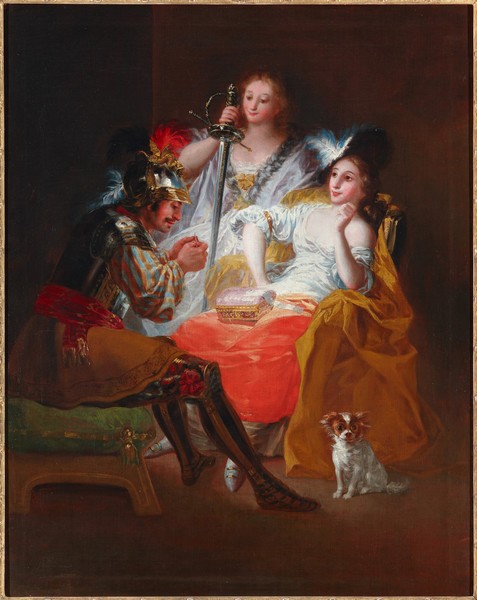- Cronología
- 1784
- Dimensiones
- 81 x 64.1 cm
- Técnica y soporte
- Oil on canvas
- Reconocimiento de la autoría de Goya
- Documented work
- Titular
- Private collection
- Ficha: realización/revisión
- 17 Feb 2010 / 14 Jun 2023
FRANCISCO DE GOYA. AÑO 1784 ("Francisco de Goya. 1784", on the blade of the sword).
We do not know the original provenance of this work. It seems that we are before a humorous mythological scene, if the traditional identification of the subject of the painting is correct. It perhaps responds to the tastes of a client, or Goya himself, as indicated by the prominence of the signature, which suggests to a close relationship between artist and client.
It belonged to the collection of the Marquises of la Torrecilla. Some time before 1928 it passed to the collection of the Duke of San Pedro de Galatina in Madrid. It was then part of the collection of the Marchioness of Valdeolmos until 1983, and was subsequently inherited by her heirs.
We can see the hero Hercules, who was made a slave by the decision of the Oracle at Delphi and bought by the Queen of Lydia, Omphale. The story goes that she sheltered Hercules in her palace, and that there the hero acquired the habits of a lady, hence his depiction in this painting carrying out some sewing while a young lady watches him, amused. Behind them we can see Omphale, who is sat holding a sword. The humour expressed in the pose of feminine delicacy adopted by the hero is added to by the fact that while he is clothed from head to foot in a manly suit of 16th-century armour he is trying to thread a needle. The three figures, seated in a circle, are lit in an unrealistic way: there is no visible source of light in the composition, although the light seems to emanate from the centre of the group.
The work is painted on a reddish ground which shows through in various places on the canvas, contributing to the vividness of the colour palette, which is very intense. The faces of the women are reminiscent of the Immaculate Conception preserved as a sketch in the Prado Museum and the artist's portraits of María Teresa de Vallabriga, the wife of the Infant Louis de Bourbon.
It was in that same year, 1784, that Goya produced the magnificent group portrait The Family of the Infante Don Luis. Juliet Wilson thinks it possible that the hidden meaning of this supposedly mythological work refers to the morganatic marriage of the infant and his bride from Zaragoza, and her purported extra-marital affairs. This is a very sensual scene in which Omphale admires her slave lover alongside her very lightly dressed companion.
The work was cleaned in 1983. The frame is not original.
-
Pinturas de GoyaMuseo Nacional del PradoMadrid1928consultant editor Fernando Álvarez de Sotomayor. From Apri to -May 1928cat. 3/73: Duque de San Pedro Galatino
-
Goya. El Capricho y la Invención. Cuadros de gabinete, bocetos y miniaturasMuseo Nacional del PradoMadrid1993from November 18th 1993 to February 15th 1994. Exhibited also at the Royal Academy of Arts, London, March 18th to June 12th 1994 and The Art Institute of Chicago, Chicago, July 16th to October 16th 1994, consultant editors Manuela B. Mena Marqués and Juliet Wilson-Bareaucat. 18
-
Goya. La imagen de la mujerMuseo Nacional del PradoMadrid2001from October 30th 2001 to February 10th 2002. Exhibitied also at the National Gallery of Art, Washington, March 10th to June 2nd 2002, consultant editor Francisco Calvo Serrallercat. 47
-
Goya: Prophet der ModerneAlte NationalgalerieBerlin2005from July 13th to October 3th 2005. Exhibitied also at the Kunsthistorischemuseum, Vienna, October 18th 2005 to January 8th 2006, consultant editor Manuela B. Mena Marquéscat. 12
-
Goya y el infante don Luis: el exilio y el reino.Palacio Real, MadridMadrid2012Arte y ciencia en la época de la ilustración española. Responsable científico Francisco Calvo Serraller. Del octubre de 2012 a enero de 2013.cat.1
-
L'œuvre peint de Goya. 4 volsParís1928-1950vol. I, p. 116, cat. 66
-
Vie et ouvre de Francisco de GoyaParísOffice du livre1970pp. 77, 93, cat. 198
-
BarcelonaPolígrafa1970vol. I, p. 260, cat. 158
-
L’opera pittorica completa di GoyaMilanRizzoli1974p. 100, cat. 173
-
Francisco de Goya, 4 vols.ZaragozaCaja de Ahorros de Zaragoza, Aragón y Rioja1980-1982vol. I, p. 158 y p. 280 (il.)
-
Goya. El capricho y la invención. Cuadros de gabinete, bocetos y miniaturasMadridMuseo del Prado1993pp. 154, 352, cat. 18 y p. 155 (il.)
